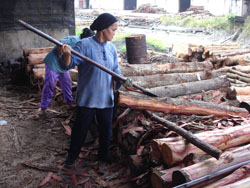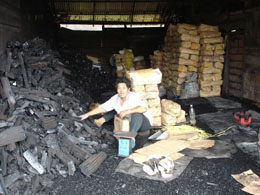As we know, Kong-Kong River is famous with many types of mangrove tree that is being process to become charcoal. Charcoal is useful in production of irons, industrial, automotive and cooking fuel, carbon source, art and medicine.
In today's entry, we will learn about the process of making charcoal...
From this:
To this:
Have you get any idea how this works???
No idea?! It's okay. I'll explain to you.
Below are the process of making charcoal.
First, logging.
Do you think all species of mangroves can be used to make charcoal?
The answer is "No!". Only bakau minyak or Rhizophora Apiculta is suitable for this purpose.
Do you think people used all entire wood and root of a mangrove tree, so they can produce a large amount of charcoal?
Again, the answer is "No!". Charcoal experts will normally use only the stem of the tree, and not the prop roots. The prop roots will be collected for firewood to heat up the kiln. It's not easy as we thought, huh?
 |
Workers collected mangroves stem. Anyway, he looks tired.
|
Second, cutting the logs into specific length.
Now, the stem had arrived to factory. The things that workers should do is select the greenwood and organize the stem according to length. They will choose best stems. The rest will become materials to burn stems until it become charcoals.
 |
Arranged stem. It's many!
|
Third, removing the barks.
The barks are removed manually using a sharp implement resembling a giant chisel. Why do think they do this? Any guess?
The answer is to increase longevity of wood because bark provides both home for damaging insects and a place for moisture to collect, which can ultimately lead to rot. Well, it's not easy to remove the bark. I bet after you've tried peeling a log or two and, after considerable effort, it will ended up with a bruise and gouged piece of wood.
Aha, wanna try? Why not you experienced it at charcoal factory near Sungai Kong-Kong?
 |
Look at the woman removed barks from stem. Salute her!
|
Forth, arranging the logs in the kiln.
What is means by kiln, anyway? Based on web translate, it is a furnace or oven for burning, baking aor drying, especially one for calcining lime or firing pottery. I will say kiln is a high place to burn stem in the process of making charcoal.
Can't imagine how would it be? What are you waiting for? Plan you visit to Sungai Kong-Kong instead of thinking.
Fifth, controlling the fire in the kiln.
The total time the logs spent in the kilns are about thirty days before they become quality charcoal. For the first ten days, roaring fire are used. More air is fed into the opening of the kiln. As they progress, air intake is reduced by sealing the opening of the kiln.
Therefore the fire will be slowly reduced. Steam will come out of a vent at the top and is collected as a useful by-product.
Clearly, the burn process take long...
Sixth, curing the charcoal.
Curing?! Seriously? Haha. Don't get things wrong.
Curing here means the logs are cured by sealing the kiln mouth altogether for a week. The temperature of the steam still smoking out of the vent will be used as an indication of the readiness of the charcoal.
 |
A mountain of charcoal after curing finish. It's lot of work, akak.
|
Lastly, packaging.
After charcoal is ready, it will be packed in the factory. Now, its ready to distribute and most of them are exported to oversea, mainly Japan. Arigatou gozaimasu!
--------------------------
You've already know how charcoal is being process. Now, its time to used them:
When you're hungry...
When you're doing you hobby
Or if you're busy to go to spa...
--- Until we meet again next time ---





.jpg)
.jpg)
.jpg)
.jpg)
.jpg)
.jpg)
.jpg)














